CO2 Insufflator: A Crucial Component in Minimally Invasive Surgery
Minimally invasive surgery has revolutionized the medical field by enabling surgeries with smaller incisions, less blood loss, reduced pain, and faster recovery time. One of the essential components of minimally invasive surgery is the insufflator, a device that maintains a constant pressure of carbon dioxide (CO2) gas in the patient's abdominal cavity during laparoscopic procedures. In this essay, we will discuss the significance of CO2 insufflation in laparoscopic surgery and the features of a typical CO2 insufflator.

CO2 insufflation is a process of inflating the abdominal cavity with CO2 gas, which creates an artificial space between organs, allowing surgeons to visualize and access them without making large incisions. CO2 is preferred over other gases for insufflation because it is non-flammable, non-explosive, and can be easily absorbed by the body. CO2 insufflation in laparoscopic surgery has several benefits, such as reducing bleeding, minimizing surgical site infections, and providing a clear view of the surgical field. Moreover, the use of CO2 gas in insufflation prevents the formation of adhesions or scar tissue, which can cause complications in the future.
A typical CO2 insufflator consists of three main parts: a gas source, a control unit, and a tubing system. The gas source is usually a tank of compressed CO2 gas that is connected to the control unit. The control unit regulates the pressure and flow of gas into the patient's abdominal cavity, ensuring that the pressure remains constant throughout the surgery. The tubing system connects the control unit to the cannula, which is a hollow tube inserted into the patient's abdomen to introduce the CO2 gas.
The pressure of CO2 gas in the patient's abdominal cavity should be monitored continuously during the surgery to ensure that it remains within the safe range. The pressure is usually maintained at 12-15 mmHg for general surgeries and up to 20 mmHg for bariatric surgeries. In case the pressure exceeds the safe range, the insufflator is equipped with safety mechanisms that automatically reduce the gas flow or shut down the system.
In conclusion, CO2 insufflation is a vital component in laparoscopic surgery that enables the visualization and access of internal organs through small incisions. The use of CO2 gas in insufflation offers numerous benefits, such as reducing blood loss, minimizing surgical site infections, and providing a clear view of the surgical field. A typical CO2 insufflator comprises a gas source, a control unit, and a tubing system, and its pressure should be continuously monitored during the surgery. With the help of CO2 insufflation, minimally invasive surgery has become a safer and more effective alternative to traditional open surgeries.
Leave a comment